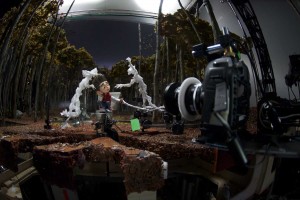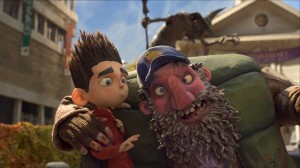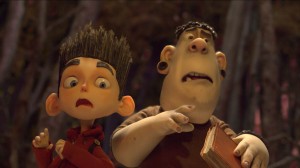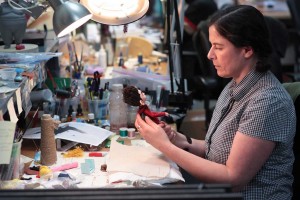
For years, there have been no stop-motion contenders for best animated feature, and now, suddenly, three come along all at once. ParaNorman is a supernatural tale of a boy, the titular Norman, living in a small New England town bewitched by a centuries-old curse, realized by freely blending the traditional technique of stop motion with the joys of modern digital effects.
Even so, directors Sam Fell and Chris Butler, both originally from the U.K., have a refreshing approach to one of the world’s oldest visual effects techniques. “It’s almost a little like live action,” says Fell, whose résumé includes work on The Tale of Desperaux and Flushed Away, not to mention three Annie award nominations (including one for ParaNorman). “It’s people, not talking animals, in a believable contemporary world.” Butler, who had initially moved to the U.S. to work “for six months… ended up staying six years.” He boasts a similarly interesting history of involvement with animated features, such as Coraline, Corpse Bride and Tarzan 2 (with two Annie nominations for Coraline and ParaNorman).

That realistic modern world was researched during the 14-month preproduction period, with Butler and Fell, alongside production designer Nelson Lowry, scouting New England towns for their “gritty” flavor. It’s not unusual for the enormous workload of an animated production to be co-directed, and in the beginning there wasn’t much division of labor, and they made most every decision together. By the time they were a year into the 18-month production period, though, they had learned each other’s tastes, and were able to brief animators separately.
And that’s a lot of animators, with up to 50 units being shot by 20-plus animators with one set being prepared while another was shot. Butler describes Laika’s studio as “a big metal shed divided up with black curtains, which ends up like a shanty town, a warren of activity and you bustle around this color-coded maze.” With microscopic planning essential for a famously labor-intensive technique, every scene became the subject of a breakdown meeting with the heads of every department, from puppets and costumes to rigging, camera and visual effects.

Director of photography Tristan Oliver (Chicken Run, Fantastic Mr Fox, Wallace and Gromit: The Curse of the Were-Rabbit) and animation supervisor Brad Schiff (Corpse Bride, Coraline, Fantastic Mr Fox) were “brought on quite early,” according to Fell. Responsible for a team of four to five cameramen and a floating resource of other crew to service the 50 sets, Oliver shot the movie using Laika’s “standard approach” of the Canon EOS 5D Mk. II, using an innovative motion control slider technique to record both 3D eyes with the same camera.
As well as extensive use of more conventional motion control, necessary to allow free camera moves with stop motion, the production had the assistance of VFX supervisor Brian Van’t Hul when applying Laika’s “huge in-house visual effects department,” which Butler describes as “unusual for a stop-motion studio.” Fell tells us that producer Travis Knight likes to refer to this arrangement as “luddites who have embraced the loom.” “There are purists who refuse any digital help, I was now delighted because of all the compositing and motion control,” Knight says. Similar technological advancement is to be found in the use of rapid prototyping – a 3D printer, essentially, capable of creating any shape with coloration included, used to realize all of the characters’ faces. A standard library was built up, as Butler tells us, providing more than 1.5 million combinations of brow and mouth. This allowed the facility for animators to request custom expressions which were developed in Maya and then sent for 3D output.

With the entire movie pre-visualised with simple paper animation, the creative part of editing had, by and large, been done by the time principal photography began. The need to re-shoot scenes, given the laborious technique, was almost entirely avoided by careful planning. Even so, Butler and Fell were able to save up two to three weeks at the end of the shoot.
With stop motion certainly less common than it once was, both directors seem genuinely pleased to have been working in the medium again, and especially to be able to polish it with modern techniques. Similarly, ParaNorman was an opportunity to express a love for 1980s films like Gremlins and ET, which famously put more than a hint of darkness into a family movie. Ultimately, a technique as time-consuming as stop motion has to be a labor of love. And so it was: Chris Butler described producer Travis Knight as “Such a flag-waver for stop motion – to set up a studio doing it, you have to love it.”





